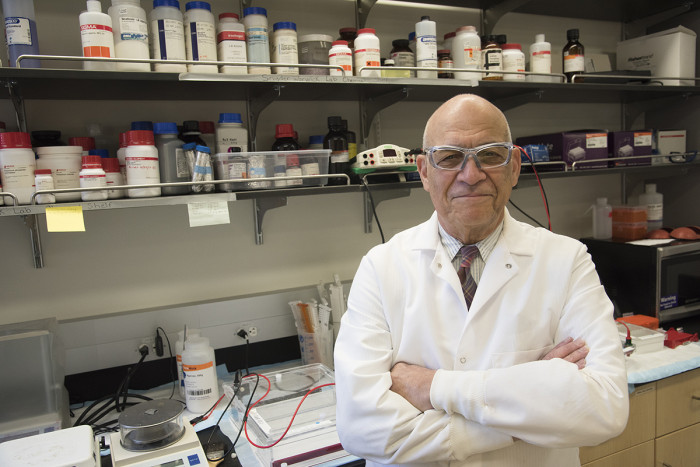Medical Campus fertile ground for drug development
Professor's research may improve treatments for infertility, growth disorders, hemophilia, other conditions
 Robert Boston
Robert BostonEarly work studying fertility hormones has led Irving Boime, PhD, and his colleagues to develop new therapeutics that may improve treatments for infertility, growth disorders and hemophilia.
Developing a new drug often takes decades, and for Irving Boime, PhD, professor of developmental biology, seeds planted more than 30 years ago now are bearing fruit. His early work studying hormones of the placenta and pituitary gland has led to technology that improves treatments for conditions as diverse as infertility, growth disorders and hemophilia.
According to Boime, this is one of the most rewarding features of conducting basic research — that experimental findings in the lab might one day be able to help patients through the development of new therapeutics.
In collaboration with Washington University’s Office of Technology Management, Boime holds patents on the discoveries, which now are licensed to pharmaceutical companies working to bring these treatments to patients worldwide.
“This work demonstrates the beauty of basic science that is applicable in medical therapies almost immediately,” said Boime, who also serves as a faculty representative for the Office of Technology Management. “It’s a perfect blend of laboratory scientists working with industry to translate basic discoveries into therapeutics and make those treatments available to patients.”
In recent decades, in vitro fertilization has helped thousands of women conceive when all other fertility treatments have failed. But the process is difficult, involving at least a week of daily injections of follicle-stimulating hormone (FSH), a protein that causes ovaries to prepare eggs for ovulation. The injections must be precisely timed, and many women need multiple rounds of therapy to achieve pregnancy. Boime and his colleagues developed a way to extend the time FSH can remain stable in the bloodstream, reducing a week’s worth of daily shots to a single injection.
“For many women, the numerous injections involved in IVF are a drawback,” Boime said. “Eliminating the need for so many shots would make it easier to follow an IVF treatment regimen that is already complex, and decrease discomfort for patients.”
While FSH is produced in the pituitary gland, it was research on a hormone made in the placenta that led Boime and his colleagues to this discovery. The placental hormone, called human chorionic gonadotropin (hCG) is closely related to FSH but lasts longer in the blood. It is involved in maintaining a pregnancy, rather than stimulating egg development.
One major structural difference between FSH and this placental hormone is a protein sequence at the end of the hCG tail that carries sugar groups. In a key discovery, the scientists found that when they removed the tail, the placental hormone’s lifespan was reduced dramatically.
“If deleting this tail makes the lifespan of the hormone shorter, we wanted to find out if adding the tail to FSH would increase its lifespan,” Boime said. “And we showed that adding the tail increases the time this modified FSH lasts in the bloodstream two- to threefold compared with native FSH.”
Clinical trials have shown that FSH carrying this sugar-tail is safe and effective in stimulating the ovaries and producing mature eggs suitable for in vitro fertilization. Though the treatment is not yet approved for use in the United States, it has been in use in over 80 countries over the past five years, including Vietnam, Australia and the countries of the European Union.
If adding this tail to the end of a fertility hormone could help it last longer in the bloodstream, the next logical step for Boime was to investigate whether the longevity of other biologically active proteins might improve with similar modification.
Human growth hormone was a natural candidate, according to Boime. The investigators showed that adding the sugar-tail to human growth hormone increases the stability of the hormone in the circulation, reducing injections from once daily to once weekly. One of Boime’s colleagues and a former postdoctoral researcher in his lab, Fuad Fares, DSc, of Carmel Medical Center in Haifa, Israel, formed a startup company to help bring this modified growth hormone formulation to patients.
These efforts have paid off. In July, the pharmaceutical company OPKO, in partnership with Pfizer, announced an agreement for developing and commercializing this modified growth hormone for treating growth hormone deficiency in adults and children. In adults, a deficiency of growth hormone can lead to insulin resistance, an increase in body fat and loss of muscle and bone density. The therapeutic is currently in phase 3 trials for adults and phase 2 trials for children.
And most recently, the technology is being investigated as a possible treatment for hemophilia, a genetic disorder in which the blood does not clot normally, increasing the risk of dangerous bleeding. In hemophilia, patients lack proteins in the blood that regulate clotting. Similar to the benefits seen in its other uses, adding the sugar-tail to these clotting factors extends their half-life in the blood, again reducing the need for so many injections in patients already at risk of bleeding.
While the conditions being treated are diverse and largely unrelated to one another, the benefit provided by the sugar-tail technology remains the same, Boime explained.
“The notion that this sugar-tail was involved in extending half-lives was proposed back in the late 1970s, early 1980s,” Boime said. “I’ve watched this research evolve gradually, working on it over many years, with many of my students and colleagues, and with many tangents along the way.”
Despite the long road, evidence of the fruits of this 30-year labor came in the early 2000s.
Recalled Boime: “A clinician running one of the modified FSH clinical trials overseas called and said, ‘We’ve got our first baby.’”






